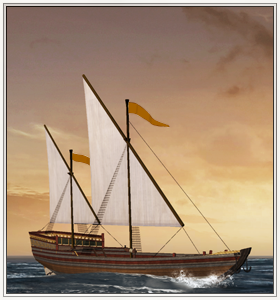Difference between revisions of "Dhow (ETW Unit)"
(→Details) |
Shackleton (talk | contribs) |
||
| Line 1: | Line 1: | ||
| − | {{Unit|image=[[Image:Dhow.png]]|Class=Trading Ship| | + | {{TW Unit|image=[[Image:Dhow.png]] |
| + | |Class=Trading Ship | ||
| + | |Unit Size=11 men | ||
| + | |Weaponry=2 guns | ||
| + | |Region=Global | ||
| + | |Recruitment Cost=500 | ||
| + | |Upkeep Cost=50 | ||
| + | |Building Requirements=Trading Port | ||
| + | |Tech Requirements=None | ||
| + | |Attributes= | ||
| + | }} | ||
| + | |||
[[Image:Dhow_thumbnail.png]]A dhow is a traditional Arab sailing vessel, rigged with a lateen sail. Although an ancient design, it is an efficient and handy craft, particularly for coastal work – and pirates! | [[Image:Dhow_thumbnail.png]]A dhow is a traditional Arab sailing vessel, rigged with a lateen sail. Although an ancient design, it is an efficient and handy craft, particularly for coastal work – and pirates! | ||
==Overview== | ==Overview== | ||
| Line 15: | Line 26: | ||
== Factions == | == Factions == | ||
| + | {{List Column|2| | ||
*[[Image:Afghanistan.jpg|25px]] [[Afghanistan (ETW Faction)|Afghanistan]] | *[[Image:Afghanistan.jpg|25px]] [[Afghanistan (ETW Faction)|Afghanistan]] | ||
*[[Image:Barbary_flag.jpg|25px]] [[Barbary States (ETW Faction)|Barbary States]] | *[[Image:Barbary_flag.jpg|25px]] [[Barbary States (ETW Faction)|Barbary States]] | ||
| Line 25: | Line 37: | ||
*[[Image:Punjab_(ETW).png|25px]] [[Punjab (ETW Faction)|Punjab]] | *[[Image:Punjab_(ETW).png|25px]] [[Punjab (ETW Faction)|Punjab]] | ||
*[[Image:Persia_flag.jpg|25px]] [[Persia (ETW Faction)|Persia]] | *[[Image:Persia_flag.jpg|25px]] [[Persia (ETW Faction)|Persia]] | ||
| + | }} | ||
[[Category:Empire Total War Units]] | [[Category:Empire Total War Units]] | ||
[[Category:ETW Ships]] | [[Category:ETW Ships]] | ||
Revision as of 16:29, 6 January 2013
 A dhow is a traditional Arab sailing vessel, rigged with a lateen sail. Although an ancient design, it is an efficient and handy craft, particularly for coastal work – and pirates!
A dhow is a traditional Arab sailing vessel, rigged with a lateen sail. Although an ancient design, it is an efficient and handy craft, particularly for coastal work – and pirates!
Overview
The design of the dhow has remained unchanged over hundreds of years; it simply doesn’t need to be improved. Used throughout the Arab world as trading boats, pirates also favour them because of their good handling, and relatively high speed. That said, the design may well be Indian in origin, later adopted by Arab seafarers. A well-handled dhow has the advantage over many European rigged ships, in that it can stay out of the firing footprint of most lumbering ships and yet is quick enough to be able to escape in even the lightest of breezes.
The lateen (or triangular) sail is also ancient design. It is not, however, perfect for all conditions. The canted lateen yardarm is difficult to handle in stormy conditions with a small crew. This may explain why the sailing rig is favoured in the Mediterranean, the Red Sea and around the Arabian peninsular rather than the Atlantic. The construction method of stitching the planks together is a unique feature of the dhow.
Historically, Europeans tended to use the term “dhow” indiscriminately to mean any vessel rigged with lateen sails. An Arab sailor would make a much finer distinction, based on the hull configuration.
Details
These ships are positively useless in any kind of offensive role, as one might expect from the number of guns and the size of the crew, as well as the fact that this is a trading vessel, not a warship. As a trade ship, dhows are excellent considering their low price, and if a reasonably large number of these vessels are active on trade slots in the game's trade theatres, then their owner can generate a tidy income, far more than the value of the ships themselves. That said, they have to be defended by warships, because they stand no chance against pirates or the navies of hostile nations.
Dhows are less expensive to recruit than Indiamen, but have higher upkeep. In the long term, Indiamen are superior trading ships for this reason.
